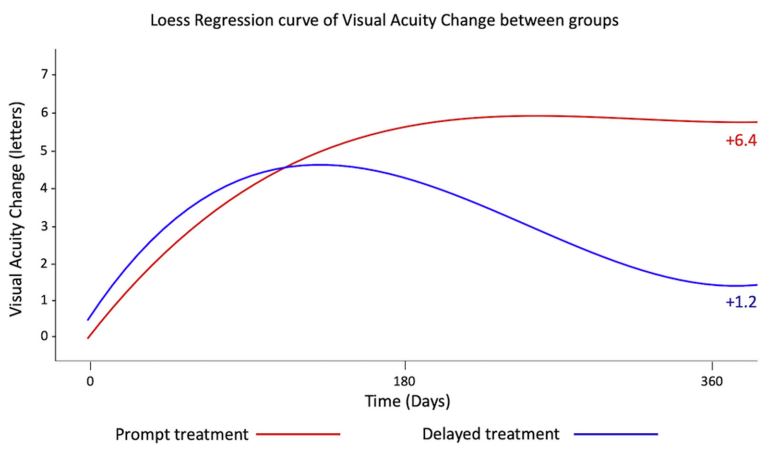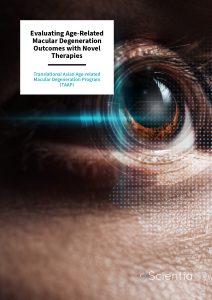Evaluating Age-Related Macular Degeneration Outcomes with Novel Therapies
Age-related macular degeneration (AMD) is a global health concern which can severely impact the quality of life(QoL) of patients. Extensive research has focussed on managing AMD, but there is a marked disparity in the treatment outcomes achieved in stringently controlled clinical trials and real-world settings. Members of the Translational Asian Age-related Macular Degeneration Program (TAAP) at the Singapore Eye Research Institute are continuing their vital work investigating the impact of different treatment regimens on patient outcomes.
Current Treatments and Outcomes
AMD is characterised by bleeding, swelling, and fluid accumulation in the retina, which can lead to permanent vision loss. Prior to permanent vision loss, a patient’s quality of life (QoL) deteriorates as eyesight gradually worsens, thus impacting mobility and emotional well-being. Evidence-based medicine using methodologically sound research procedures can help to inform optimal treatment planning. Although extensive clinical trials have been conducted during the past decade, the findings are often not reproducible in real-world medicine. Moreover, there is a paucity of published evidence relating to AMD in non-Western populations. This is a critical omission since the prevalence and incidence of AMD subtypes differs across geographical regions; in Europe and America, the most common form of AMD is choroidal neovascularisation (CNV), but in Asia, polypoidal choroidal vasculopathy (PCV) predominates.
Injections of vascular endothelial growth factor (VEGF) inhibitors are a well-established therapeutic intervention for AMD. However, traditionally, these have been strictly administered monthly, which is inconvenient and exacerbates financial pressures, leading to non-compliance and disease progression. There is a growing trend for implementing more flexible administration schedules to reduce dosing frequency and clinic attendance while maintaining favourable patient outcomes. Therefore, by monitoring and analysing the outcomes achieved during real-world clinical practice in Singapore, a more accurate insight into how specific treatments and schedules may pan out in ageing Asian communities can be achieved.
In recent years, the researchers and clinicians forming the Translational Asian Age-related Macular Degeneration Program (TAAP) at the Singapore Eye Research Institute, along with colleagues at various renowned Institutes and Universities around the world, have been conducting cutting-edge research into AMD in Asians of advancing age. The main aims of their studies have been to evaluate the most appropriate drug regimens and the optimal interval between treatments, depending upon the disease type and disease activity, using real-world data and bio-imaging techniques. Moreover, in TAAP’s efforts to better understand the impact of AMD on QoL in Asia and the effectiveness of AMD clinical management from the perspective of patients, a state-of-the-art AMD-specific computerised adaptive system is being developed and validated.

Credit: TAAP
Enhancing Outcomes with Adjunct Treatments
The work undertaken by the TAAP group has been introduced in an earlier article. The objectives of their studies at the time of publication were to elucidate disease mechanisms, develop novel, sophisticated diagnostic technologies, optimise treatments, and increase understanding of the impact of AMD on those experiencing the condition to help improve patient outcomes.
The cornerstone of the TAAP team’s research is accumulating real-world evidence. Recently, the team conducted a study comparing the outcomes of first-time AMD-CNV and AMD-PCV treatments in Asian patients using either traditional anti-VEGF monotherapy alone or in adjunct with photodynamic therapy (PDT).
Existing data in which detailed baseline measurements taken before treatment commenced were used by the team. Initial treatments and scheduled re-treatments had been tailored according to individual clinical characteristics, which is the recommended approach for optimal outcomes.
The frequency of injections received during the first 12 months of treatment was a good predictor of visual improvement. Greater improvements in visual acuity were found for patients who received between 4–7 injections compared to those who received fewer injections. Whilst treating AMD-CNV with anti-VEGF in this study was comparable to other real-world studies in Western countries, outcomes were not as successful as in clinical trials. However, using combination therapy for AMD-PCV patients yielded improvements in vision comparable to those achieved in controlled trials – an outcome virtually unheard of previously.
The Importance of Timing
Having determined the impact of the number of injections administered over a set period on visual improvement in AMD, Dr Teo’s team turned their attention to the ramifications of extended intervals between injections in patients with active neovascular disease. Delayed treatment was defined as missing injections at two or more assessment appointments in 12 months when active disease was observed, whilst timely re-treatment was defined as receiving treatment when the disease was active.
The team found that patients whose active disease was not managed promptly had significantly reduced visual gains than those treated in a more timely manner, and that any gain in visual function upon initiation of treatment was lost. Furthermore, patients treated more promptly attended a significantly higher number of assessment appointments, corresponding with closer monitoring of the disease state. The increased number of assessment appointments was also associated with shorter intervals between treatments, which improved visual acuity during the 12-month period compared to delayed re-treatment following the reactivation of disease.
This novel finding confirmed that, regardless of the number of injections received over the treatment period, a longer interval between injections in patients with active AMD has a significant deleterious effect on clinical outcomes. The team concurred that a bespoke treatment regime that considers individual disease patterns and accounts for the temporal nature of disease activity may be more important than the actual number of injections received, and that acting immediately upon detection of active disease will assist in optimising treatment schedules and informing best clinical practice.

Credit: TAAP
Mitigating the Impact of Unintentional Delays
Expanding on these findings, the team analysed a large patient data set to investigate the impact of unintentional deviations from planned treatment schedules in the context of clinical adjustments necessitated by the recent COVID-19 pandemic. Dr Teo’s team found that there was a significant loss in visual acuity and, therefore, a risk to salvageable vision when the interval between injections was extended to 12 weeks and longer in patients with active disease compared to treatment intervals of 6 weeks or less over a period of six months. However, the team also noted that vision can remain relatively stable for up to six months, even at 10–12-week injection intervals. Although the analysis was conducted on data obtained previously, the study was useful in assisting clinicians in treatment planning during the unprecedented COVID-19 pandemic.
Of course, whilst the findings are valid in the event of a similar crisis in the future, they are also applicable to unexpected treatment schedule deviations in real-world medicine in regular circumstances, which may be caused by extended hospital stays, periods of illness, fear of treatment, or patient non-compliance due to poor understanding of associated consequences.
Developing a Novel Quality of Life Evaluation Tool
Whilst current treatments for AMD undoubtedly improve clinical outcomes such as visual acuity, the impact of treatments from the patient’s perspective is comparatively less well understood. As such, it is imperative that the patient is involved in planning future therapeutic approaches. Collecting quantitative patient-reported data has traditionally been achieved using questionnaires. However, these are often lengthy and may be burdensome to complete. Moreover, in the case of ‘paper-pencil’ questionnaires, data entry and scoring must be done manually, and real-time reporting is not possible.
To overcome these issues, item banking (IB) and computerised adaptive testing (CAT) can be used to obtain accurate estimations of a range of QoL constructs (e.g. activity limitation, mobility, emotional well-being, concerns, AMD management). IBs comprise a large bank of items, calibrated in terms of relative difficulty like a ruler, that are administered using a CAT algorithm that is based on artificial intelligence. The CAT selects items from the bank that most closely target the person’s QoL at that point in the test. This ‘smart technology’ means that precise estimates of each QoL construct can be obtained using very few items. Importantly, as each QoL item bank functions independently, users can select relevant domains for their sample population (e.g., the AMD Management domain may be more relevant to patients on treatment), and this feature makes it very useful in optimising treatment plans for patients alongside the standard clinical and imaging data.
Professor Ecosse Lamoureux and A/Prof Eva Fenwick are currently working on the development of an IB/CAT system (MacCAT) to specifically assess QoL in AMD patients. While the MacCAT is being developed in Singapore, its content was derived from both interviews with Singaporean patients with AMD/PCV and currently available literature on the QoL impact of AMD in Western and other populations, meaning it has global applicability. The pilot version of MacCAT has been tested in a large patient cohort from which calibrations for the item bank have been calculated. CATs covering six domains of QoL have been built on the team’s secure, cloud-based platform, and the performance of the CATs is currently being evaluated in another large clinical sample. Undoubtedly, this innovative system will pave the way for a more refined method for holistically measuring the impact of AMD on QoL, leading to improved monitoring of patient well-being, bespoke treatments, and an increase in desired clinical outcomes.
Certainly, the TAAP team of researchers have exceeded their goals thus far. They will unquestionably achieve their ultimate goal of removing the barriers to effective treatment and improving the lives of individuals with this debilitating condition.
SHARE
DOWNLOAD E-BOOK
REFERENCE
https://doi.org/10.33548/SCIENTIA1009
MEET THE RESEARCHER

Associate Professor Kelvin Teo
Singapore National Eye Centre
Singapore
Associate Professor Kelvin Teo is a senior consultant at the Singapore National Eye Centre and has a strong interest in clinical research in the field of medical retina. In particular, his focus is on real-world outcomes and how imaging techniques help to advance the pathophysiology and therapy of neovascular age-related macular degeneration.

Professor Ecosse Lamoureux
Duke-NUS Medical School
Singapore
Professor Ecosse Lamoureux is a tenured Professor at Duke-NUS Medical School. He undertakes his clinical research at the Singapore Eye Research Institute, where he is the Director of the Population Research and Clinical Epidemiology platform. His contribution to population eye health research is significant. He leads the patient-reported outcomes research component of the Singapore Epidemiology of Eye Diseases programme. He has contributed significantly to a better understanding of the economic, social and personal burden and considerable impact of vision impairment and ocular pathologies in Singapore and Asia. His recent work includes a large population-based study to understand better the burden and complex mechanisms underlying age-related sensory decline in Singapore.
CONTACT
FUNDING
Singapore National Medical Research Council Open Fund Large Collaborative Grant: NMRC/LCG/004/2018
FURTHER READING
- KY Chong Teo, V Nguyen, CM Gemmy Cheung, et al., The Impact of Disease Activity on 5-year Outcomes in Patients Undergoing Treatment for Neovascular Age-Related Macular Degeneration, Retina, 2022, 42(1), 95–106. DOI: https://doi.org/10.1097/IAE.0000000000003267
- EK Fenwick, EPX Lee, REK Man, et al., Identifying the content for an item bank and computerized adaptive testing system to measure the impact of age-related macular degeneration on health-related quality of life, Quality of Life Research, 2022, 31(4), 1237–1246. DOI: https://doi.org/10.1007/s11136-021-02989-w
- REK Man, ATL Gan, EK Fenwick, et al., Impact of Incident Age-related Macular Degeneration and Associated Vision Loss on Vision-Related Quality of Life, British Journal of Ophthalmology, 2021, 106(8), 1063-1068. DOI: https://doi.org/10.1136/bjophthalmol-2020-318269
- KY Chong Teo et al., Patterns and Characteristics of a Real-World Implementation of a Self-Monitoring Program for Retina Diseases during COVID-19 Pandemic, Ophthalmology Retina, 2021, S2468-6530(21)00055-5). DOI: https://doi.org/10.1016/j.oret.2021.02.005
- KY Chong Teo, N Saxena, A Gan, et al., Detrimental Effect of Delayed Re-treatment of Active Disease on Outcomes in Neovascular Age-Related Macular Degeneration: The RAMPS Study, Ophthalmology Retina, 2020, 4(9), 871–880. DOI: https://doi.org/10.1016/j.oret.2020.03.017
- EK Fenwick, CMG Cheung, PG Ong, et al., The impact of neovascular age-related macular degeneration and polypoidal choroidal vasculopathy on vision-related quality of life in Asian patients, British Journal of Ophthalmology, 2017, 101(5), 591–596. DOI: https://doi.org/10.1136/bjophthalmol-2016-308541
REPUBLISH OUR ARTICLES
We encourage all formats of sharing and republishing of our articles. Whether you want to host on your website, publication or blog, we welcome this. Find out more
Creative Commons Licence (CC BY 4.0)
This work is licensed under a Creative Commons Attribution 4.0 International License. 
What does this mean?
Share: You can copy and redistribute the material in any medium or format
Adapt: You can change, and build upon the material for any purpose, even commercially.
Credit: You must give appropriate credit, provide a link to the license, and indicate if changes were made.
SUBSCRIBE NOW
Follow Us
MORE ARTICLES YOU MAY LIKE
Dr Ralf Adam | New Technologies Shaping the Future of Oral Hygiene
Understanding the efficiency of various toothbrush technologies is essential for achieving optimal oral health. Dr Ralf Adam, who leads a dedicated team at Procter & Gamble in Germany, is keen to investigate the complexities of these technologies. His team have provided new insights into the best toothbrush types for plaque removal and the maintenance of gum health. By highlighting the importance of informed oral care decisions and ongoing investigations, this vital research works towards ensuring everyone can achieve a brighter, healthier smile.
Dr Toby Phesse | Revealing the Mysteries of Wnt Signalling: Novel Approaches to Beating Cancer
Cancer remains a leading cause of mortality worldwide, and the need for new, more effective treatments remains an urgent challenge. Dr Toby Phesse from Cardiff University in the UK focuses on the role of the Wnt receptor found on the surface of cells and its involvement with cell communication and cancer growth, bringing fresh hopes for new therapeutic options.
Dr Vijay Reddy | The Virus World Database: An Invaluable Resource for Public Health and Healthcare
Severe viral disease presents an ongoing challenge to the health of humankind. While unparalleled developments in science and technology are improving our understanding of such viruses, this information needs to be readily accessible to researchers to ensure continued progress in public health and healthcare. Dr Vijay Reddy and his colleagues at the Hormel Institute (University of Minnesota) developed the Virus World database, an invaluable resource that details the genome, structure, and host of practically every discovered virus to date.
Professor Ralf Herwig | Deciphering the Enigma of Vitamin D and the Immune System
Vitamin D has been studied as a treatment for a large number of diseases and conditions, from cancer to autism to COVID-19. However, its mode of action is not completely understood. Professor Ralf Herwig carries out his research at HG Pharma GmbH (Austria) and Ulster University (UK). His vital work explores the role of vitamin D in the body with a view to unlocking its potential as a treatment for a variety of health conditions involving the immune system.





